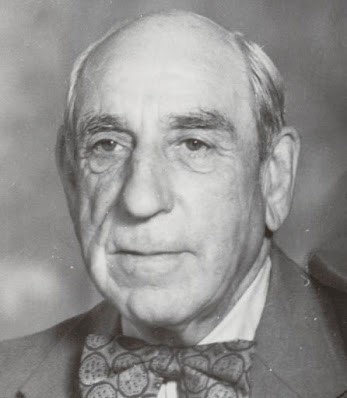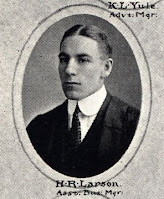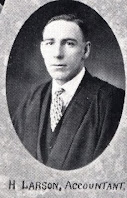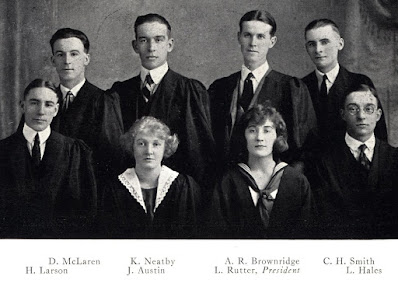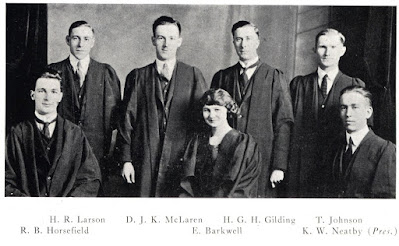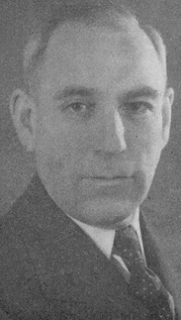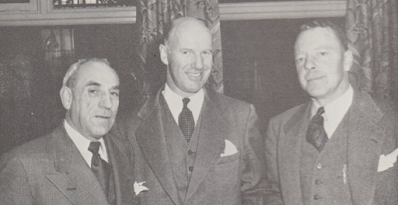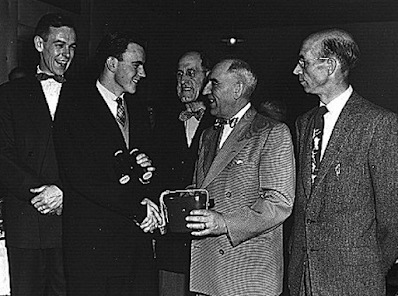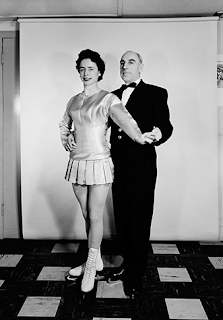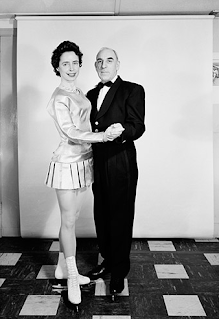Photo courtesy Saskatchewan Sports Hall Of Fame
"Herb was a feisty, tough little guy who wasn't going to take crap from anybody. He'd take on anything given the proper environment and motivation." - Hugh Glynn, "Reflections Of The CFSA: A History Of The Canadian Figure Skating Association"
"It has always been my aim and endeavour to bring to any office I hold in figure skating activities a sense of sportsmanship... My main interest seems to have been to encourage young boys to take up figure skating and to obliterate the word 'fancy' and replace it with 'figure'." - Herbert Larson, "Skating" magazine, February 1953
The son of Johanna 'Anna' (Swanson) and Swedish immigrant Sven Johan Larson, Herbert 'Herb' Reginald Larson was born on July 1, 1899 in Genesee, Illinois. His parents, who were staunch Lutherans, moved north to in Lost River, Saskatchewan when he was a young boy. He was the third oldest of five boys and spent much of his youth working long, harsh days on the family homestead.
Photos courtesy University Of Saskatchewan Special Collections
As a young man, Herbert worked on the farm of a German family and saved up enough money to attend Nutana Collegiate and the University Of Saskatchewan. He was active in numerous aspects of school life at the University, including the yearbook and amateur dramatic society. He graduated from the College Of Commerce in 1925, settled in Saskatoon, married his wife Lillian (Howatt) and had two children, Mavis and Lorne.
Photos courtesy University Of Saskatchewan Special Collections
An ambitious and community-minded man, Herbert served as the provincial chairman of the Canadian Manufacturers Association, President of the Saskatoon Petroleum Club, an executive member of the Saskatchewan War Finance Committee, Saskatchewan Motor Club and Fish and Game League and was active in his local public library, Kinsmen and Rotary Club's. He was the owner of School Publications and Specialties, which produced materials for Saskatchewan schools. He later founded the very successful H.R. Larson Publishing Company, also known as Midwest Litho. One of his employees was Mary Rose Thacker's brother Ross. In his spare time, he enjoyed curling, hunting, fishing, square dancing, shuffleboard and figure skating.
Herbert Larson's business Midwest Litho. Photo courtesy Saskatoon Public Library.
As director and President of the Saskatoon Figure Skating Club, Herbert was keenly aware of the problems that Western skaters faced. With few exceptions, the CFSA was run by an 'old boy's club' from Eastern clubs. The Canadian Championships and AGM's were almost always held in Eastern Canada... and stacked full of Eastern judges. Travel was also an issue. If skaters couldn't afford train tickets and accommodations, they couldn't even attend Canadians. With an aim to improve this situation, he worked with a small group of Westerners, including Granville Mayall, Bert Penfold and Aileen Abbott, to form the sprawling Western Canada Section of the CFSA, which stretched from Victoria, B.C. to Port Arthur, Ontario in 1946. He later served as its President.
Undaunted by a harrowing car accident in the autumn of 1950 that saw his Ford Meteor plunge through the ice of Redberry Lake, Herbert served as the chairman of the Western Canadian Championships and became certified as a Gold level judge and referee with the CFSA. From 1951 to 1953, he served as the CFSA's Vice-President. In 1953, he began his tumultuous and controversial reign as the CFSA's President - only the second man from Western Canada to hold the position.
Herbert Larson, Donald B. Cruikshank and F. Herbert Crispo. Photo courtesy "Skating" magazine.
As CFSA President, Herbert was - to put it diplomatically - a polarizing figure. The first Western Canadian President, Alf Williams, had been happy to tow the line. Herbert wanted to shake the tree and make drastic changes to how the Association was run. He was extremely vocal about his desire to diminish the control of the clique of Ontarians that he called "the Eastern combine" and this, of course, made him quite unpopular with the CFSA's long-held 'establishment'.
Herbert Larson shaking hands with Charles Snelling. Photo courtesy Saskatoon Public Library.
When Herbert came up with the idea visiting many of the one hundred and thirty-eight member clubs to try to establish some sort of working relationship and in-person connection, this ruffled feathers because he paid for these trips out of his own pocket. Donald B. Cruikshank, the CFSA's Past-President, briskly stepped in with a motion that all travel by the CFSA's Presidents be approved and paid for the Association. Not long after, his fellow executive members changed the rules of the Association and called a surprise election for President. It was actually the first time in the long history of the ASAC or CFSA that there had been an election for President - everyone else had been essentially appointed. In order to defeat his opponent from Toronto, Herbert took advantage of a rule that allowed member clubs to send in their votes by proxy, enlisting key builders from the Western provinces in a campaign that involved travelling to clubs from Victoria to Regina. This cunning strategy paid off and he was re-elected to serve as President for a second year. He didn't stand for re-election in 1955 and F. Herbert Crispo, the man he'd defeated in 1954, succeeded him as President.
Alma English and Herbert Larson. Photos courtesy Saskatoon Public Library.
After his presidency of CFSA, Herbert resumed his service on the executive of the Western Canada Section and won the 1958 Western Canadian veteran's ice dance title with Alma English. He was inducted into the Saskatchewan Sports Hall Of Fame in 1977. Upon his retirement, he moved to Victoria, British Columbia, where he founded the Kinsmen K-60 Club and served as President of the Oak Bay Senior Kiwanis Club. He passed away on December 19, 1996 at the age of ninety-seven. In 1998, Herbert's children established the Larson Family Fund in his memory for the Saskatoon Foundation, which contributes to funding various local programs.
Skate Guard is a blog dedicated to preserving the rich, colourful and fascinating history of figure skating. Over ten years, the blog has featured over a thousand free articles covering all aspects of the sport's history, as well as four compelling in-depth features. To read the latest articles, follow the blog on Facebook, Twitter, Pinterest and YouTube. If you enjoy Skate Guard, please show your support for this archive by ordering a copy of the figure skating reference books "The Almanac of Canadian Figure Skating", "Technical Merit: A History of Figure Skating Jumps" and "A Bibliography of Figure Skating": https://skateguard1.blogspot.com/p/buy-book.html.

